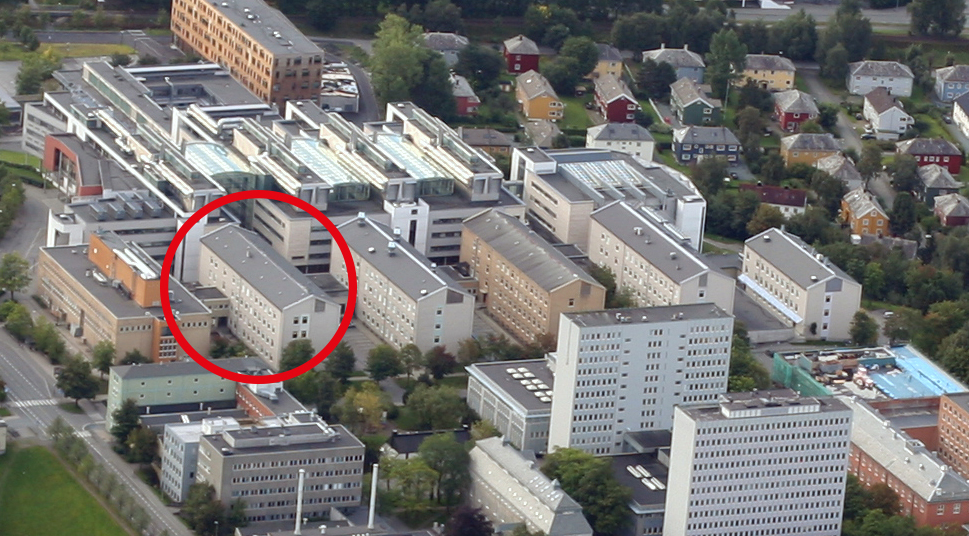ESFRI - project - 2019 - Campus development
ESFRI-project: Rebuilding of areas for capture and storage of CO2
ESFRI-project: Rebuilding of areas for capture and storage of CO2
A co-located campus in Trondheim involves rebuilding of areas for Carbon Capture and Storage (CCS) as part of NTNU’s work within European research infrastructure (ESFRI).
 Chemistry Block 5 is the last of the chemistry blocks to be renovated. Photo: Lars Strømmen.
Chemistry Block 5 is the last of the chemistry blocks to be renovated. Photo: Lars Strømmen. Written by: May Brit Leirtrø Røstad
January 2009, Norway was appointed by the co-operation forum ESFRI (European Strategy Forum on Research Infrastructures) to host the joint European initiative on laboratories for research on CO2 handling.
Cooperation between NTNU and SINTEF
CO2 capture and storage (CCS) has for a long time been a high priority national field of research. The government has invested considerable resources in making ESFRI a national flagship project. NTNU and SINTEF submitted their application with the short name ECCSEL (European Carbon dioxide Capture and Storage Laboratory Infrastructure). Through the joint decision of the Ministry of Education and research, the Research Council of Norway and NTNU/SINTEF, the ESFRI-project was formed as a pan-European research infrastructure for CO2 capture and storage, and NTNU as the coordinator.
Chemical catalysis is one of the main areas of research. Catalysis is a method that makes a chemical reaction easier and more specifically produces the products you want and not the by-product. Chemical catalysis is, for instance, central to some processes for producing biofuels and for converting CO2 into useful products such as fuel and methanol.
Chemical block 5 remains
A recent report from the Intergovernmental Panel on Climate Change (IPCC) clarifies the importance for rapid progress in carbon capture and storage (CSS). The ESFRI project was planned with a comprehensive upgrading of the laboratory infrastructure and building adjustments in the chemical buildings and Heat Engineering laboratory at Gløshaugen. The latter has one of the country’s leading laboratories within carbon capture, transport and storage. Measures remain in Chemical block 5, which currently is used to develop newer innovative solutions for CO2 capture integrated with energy production.
The block is the last of the chemical blocks to be refurbished. The ventilation capacity and the overall condition of this block allow only partial utilization of laboratory infrastructure and office space. With growing activity, the situation is now precarious, and means that it is not possible to extract the full potential of innovation and research projects in the field of CO2 capture in line with the strategy of sustainable solutions.
For NTNU’s project for a co-located campus, areas for ESFRI on CO2 capture and storage in Chemical block 5 is a part of the 45000 square meters area framework for rebuilding.
Background information
100 years ago, one discovered that an apparently insignificant concentration of CO2 in the atmosphere retains just enough amount of the sun’s heat. It was also clear that an increase in CO2 concentration due to combustion of coal, oil and gas heats the earth’s surface, both over land and sea. Only in the last few decades a unified field of science started to gather evidence and knowledge of what damage such heating causes.
Through research scientists have tested solutions that remove CO2 from industrial emissions and permanently store it in porous rocks. In this process, one captures CO2 from large point emissions and stores it in special underground formations, about 1 – 3 kilometres below the seabed. Here it will lie as oil and gas did into the unforeseeable future. It is believed that after 10,000 years, 95 percent of CO2 will be dissolved in water and 5 percent will be mineralized. There will be no pure CO2 left, and no need not worry about leaks. (Source: Article on carbon capture and storage – in Norwegian).
Norway and the rest of the world must cut greenhouse gas emissions over the next decades andcarbon capture is an important part of this shift.
